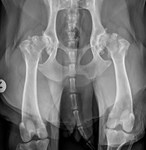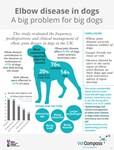Search - VetCompass
81 - 88 of 88 results
-
'Rottweilers top the lame list’ say RVC
Rottweilers are the most predisposed dog breed to suffer from osteoarthritis according to new research from the Royal Veterinary College (RVC). Osteoarthritis is the most common joint disease diagnosed in dogs, and this study is the largest ever conducted into the condition in dogs under veterinary care – covering 455,557 dogs -
World’s largest elbow disease study helps owners of large-breed dogs
The Royal Veterinary College (RVC) has just completed the largest ever study of elbow disease in dogs attending first opinion veterinary practices in the UK. The results have highlighted which breeds are most at risk in order to assist owners to be alert for the signs of this condition and to seek veterinary treatment early. -
RVC Research study reveals consequences of extreme demand for puppies during COVID-19 Pandemic
RVC study reveals why so many people bought puppies during the pandemic and the consequences of this extreme demand -
New RVC research helps owners better understand the remaining life expectancy of dogs
New research from the Royal Veterinary College’s (RVC) VetCompass programme now enables owners to predict the remaining life expectancy of their dog from different ages, with results broken down by breed and gender to make these as useful as possible for owners of many breeds in the UK. The findings also identify breeds with the greatest and lowest life expectancies of the 18 breeds in the study, highlighting wide differences in life expectancy amongst popular breeds. -
New research finds Rottweilers at greatest risk of cranial cruciate ligament rupture
A new study from the Royal Veterinary College (RVC) explores the reasons for cranial cruciate ligament (CCL) rupture in dogs in the UK, as well as the factors influencing how it is managed clinically. The research also identifies which breeds are … -
British bulldog ownership has doubled but breed faces high risk of skin disease and obesity
Findings show that due to breeding trends 12.7% of British bulldogs suffer from ear infections, 8.8% from skin infections and 8.7% from obesity -
New RVC research reveals later-age spaying of bitches reduces risk of urinary incontinence
A new study from the Royal Veterinary College (RVC) has revealed that delaying spaying of bitches until between seven and 18 months causes a 20 percent reduction in the risk of early-onset urinary incontinence, compared with early-age spaying … -
New research from the RVC lifts the lid on dog breeds suffering from abnormal eyelids
A new study from the Royal Veterinary College’s (RVC) VetCompass Programme has revealed the scale of serious welfare issues associated with dog breeds that have abnormal eyelid positioning that many people still consider as ‘normal for the breed’. …








